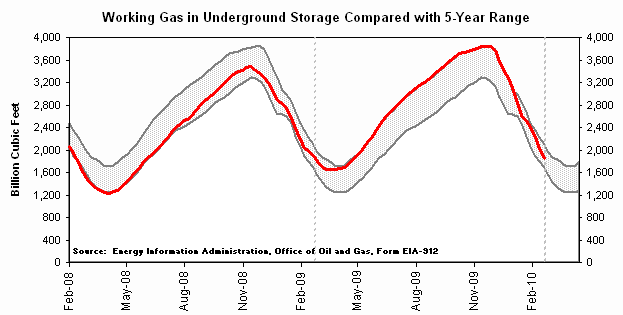Successful exploration of natural gas from shale has contributed to a drop in natural gas prices during the past two years. Yet the large energy companies have taken notice of the potential from natural gas from shale, lead by Exxon’s acquisition of XTO Energy and the Total/Chesapeake joint venture. Does the move by “Big Oil” indicate a strong future for shale based natural gas?
According to the
Energy Information
Administration, the weekly update for

As the volume of gas in storage falls, you would expect the
number of natural gas rigs to increase. As of Friday, February 19, the natural
gas rotary rig count rose to 893, an increase of 2 from the previous week,
according to Baker Hughes Incorporated data. This marks the eighth consecutive
week that the natural gas rig count has risen, and is now at its highest level
since

Increased drilling activities accompany the need for more capital to fund lease purchases, as well as exploration and production activities. The problem is many analysts believe that natural gas from shale has yet to be cash flow positive. The independents focused much of their capital on acquisition of acreage. Now they must shift to exploration and production to generate sufficient returns. The problem is the production profiles of many of these shale natural gas fields might not achieve historical trends. While their initial flow rates are impressive, these fields have experienced a more rapid production decline that more normal fields, indicating the shale plays may not be as cash flow positive as many expect.
As a result, many independents are looking for ways to exploit their large investments in natural gas shale acres without increasing their capital requirements. Along come the big energy companies with their vast amount of capital. The large companies are exchanging their capital for access to horizontal drilling and hydraulic fracturing technologies. Big oil wants to develop their expertise in shale exploration and production to take it globally.
With high acreage costs, large royalty payments, and expensive production wells, many analysts question the ability of the independent natural gas companies to generate a profit at current price levels. Many analysts believe gas prices must rise to the $7 to $8 per Million cubic feet (Mcf) level before the gas producers can make a profit.
Exxon’s purchase of XTO at a 25% premium indicates that the major oil companies believe that shale has a future. The major oil companies have the financial resources to weather lower gas prices. By acquiring the expertise that the independent’s posses in developing gas shale, the majors are looking to find and produce gas from U.S. Canadian and other international plays. Therefore, we should look for additional acquisitions and joint ventures in the months to come. Some of the companies that come to mind are Petrohawk (HK), Range Resources (RRC), Cabot Oil & Gas (COG), Quicksilver Resources (KWK), among many others.
